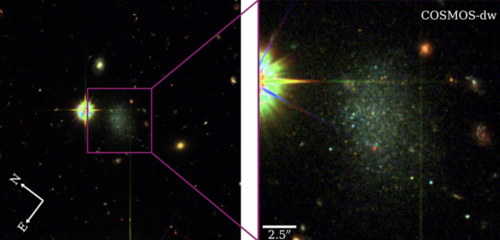Image courtesy of Polzin et al.
Galaxies, like humans, can be quenched—not in the way that humans drink water, but in the way that galaxies form stars.
Think of a galaxy as a lightbulb factory. Imagine you walked into this factory immediately after it stopped operating. You would see all the newly manufactured light bulbs and could conclude the factory must have recently stopped its production. A recently quenched galaxy is a recently dysfunctional star factory that still contains newly formed stars even though there is no active star formation.
Ava Polzin—a Yale graduate student working in the lab of Pieter van Dokkum, professor of astronomy—researched a recently discovered galaxy known as COSMOS-dw1. COSMOS-dw1 is a dim, small, low-mass, isolated dwarf galaxy that lies far outside the gravitational influence of our local group of galaxies—including the Milky Way—at a distance of approximately twenty-two megaparsecs (Mpc). Before starting her research, Polzin already believed the galaxy to be quenched, but after examining its properties, including its stars and spectroscopy, she concluded the galaxy had only recently stopped its star formation, defining it as “recently quenched.” Finding an isolated quenched galaxy in this mass regime is rare. And to find one at this pivotal point of its lifespan and outside of the local group was a first. “COSMOS-dw1 deserved its own paper,” Polzin said.
COSMOS-dw1 is fascinating for how it stopped producing stars—in other words, how it became quenched. Other well-studied quenched galaxies have been assumed to discontinue their star formation due to their passing through a more massive galaxy. COSMOS-dw1 is at such a great distance from any large galaxy that Polzin concluded an internal occurrence must have ended its star formation. This exact occurrence, however, still requires further research. Currently, stellar explosions known as supernovae and other forms of energy released from stars are thought to drive quenching for low mass galaxies. Thus, Polzin hypothesizes that the young, blue stars in the galaxy might be remnants of the event that halted COSMOS-dw1’s star formation.
COSMOS-dw1’s low luminosity combined with its far distance made the study immensely difficult. Since low mass galaxies have low luminosities, the only well-studied low mass galaxies are less than three Mpc away from our local group of galaxies, compared to COSMOS-dw1’s significantly farther twenty-two Mpc. Several sky surveys initially overlooked the potential interest of COSMOS-dw1 due to its challenging characteristics. According to Polzin, the designs of most of these surveys are “biased” against quenched galaxies due to their generally older and less luminous stellar populations.
As new wide-field surveys and instruments are developing, we must understand the flaws in our current methods. Polzin’s study exemplifies the need for improved surveying techniques and analysis of survey data. Galaxies like COSMOS-dw1 may not be that rare in actuality—just difficult to find with our current approaches.

